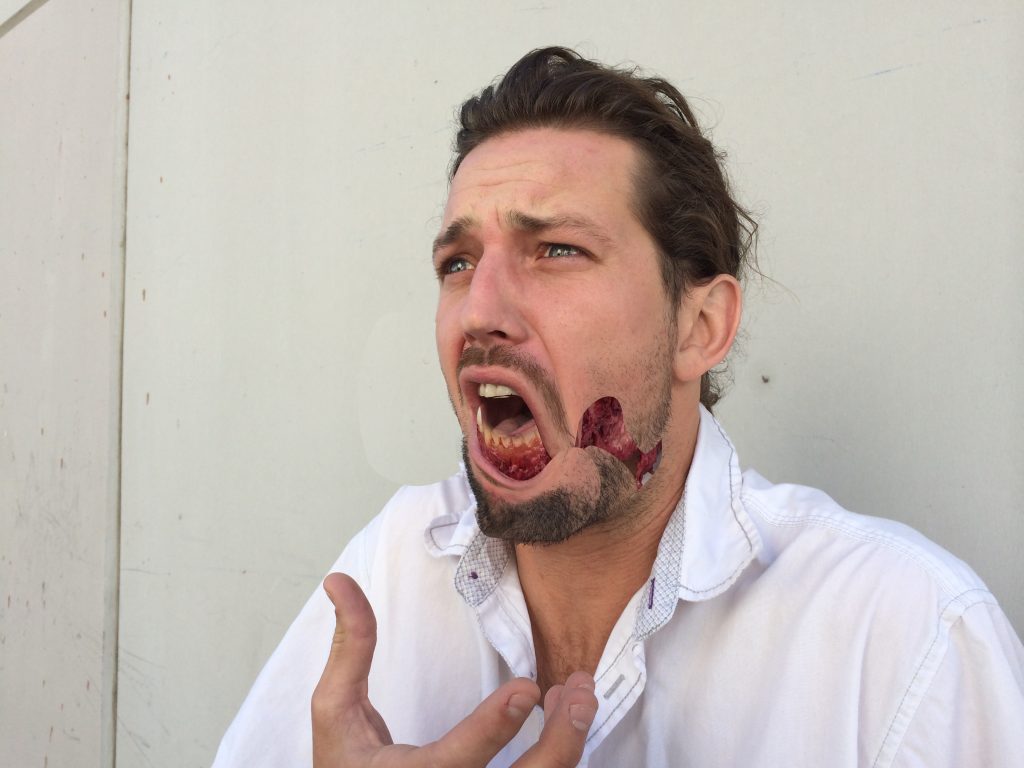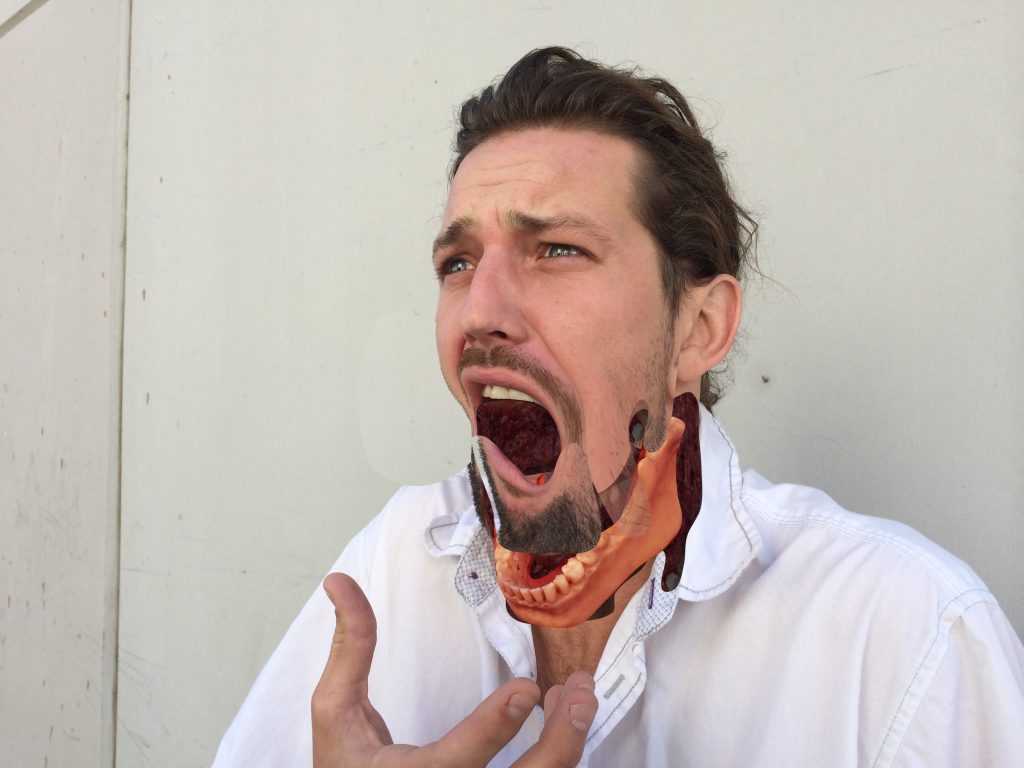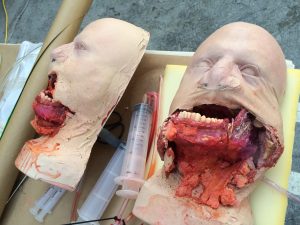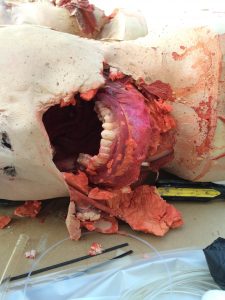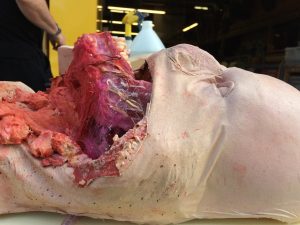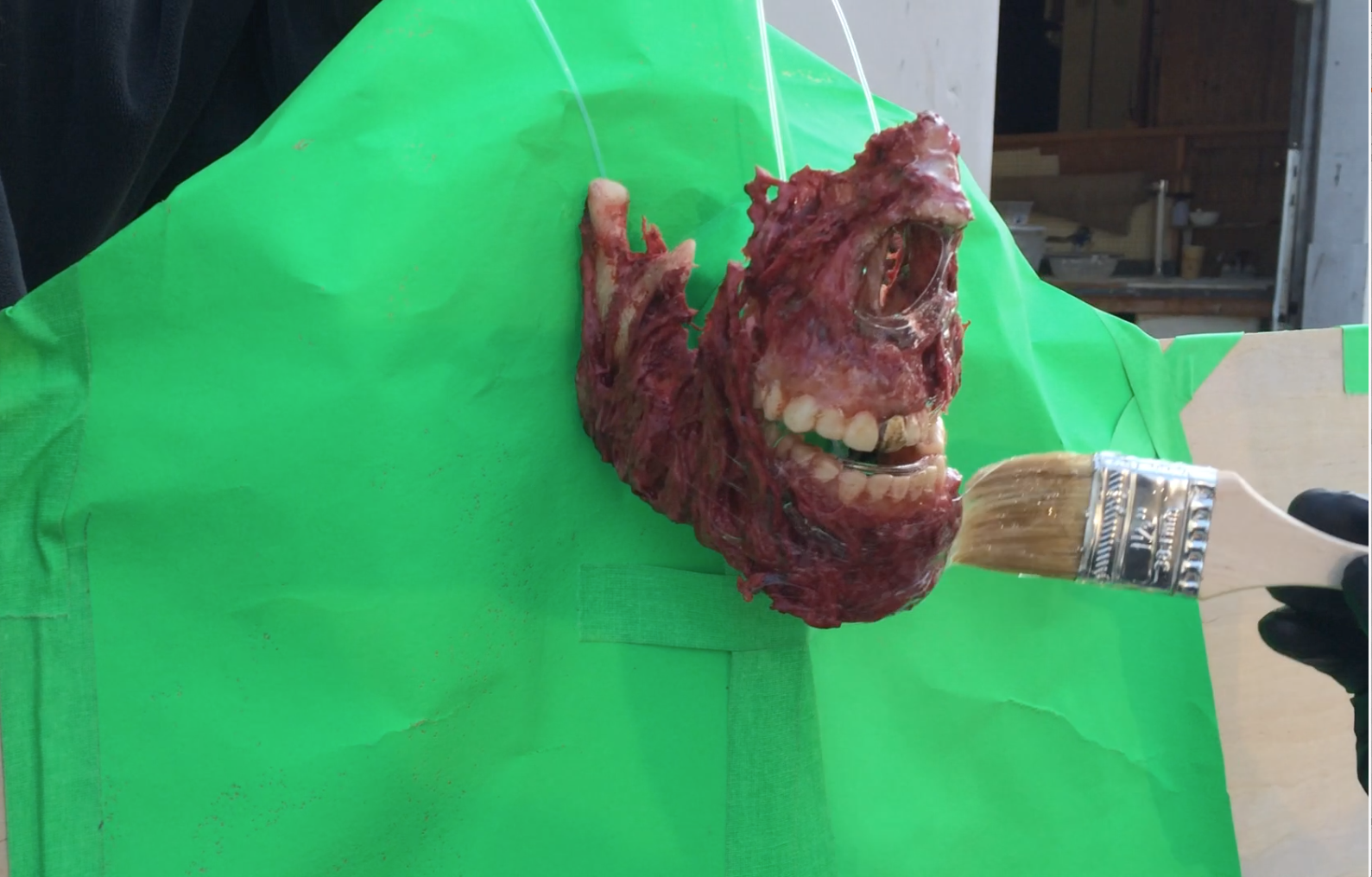 Melting Faces For Falling Skies With Baking Goods and Computers
Melting Faces For Falling Skies With Baking Goods and Computers
WARNING: This article contains simulated gore, and may not be suitable for children under the age of 12 (after that age, you may have to contain their glee).
One of the more frightening and effective images over the history of movies is that of a melting person. Despite the fact that people do not generally melt, it is a recurring theme. The Wicked Witch of the West in The Wizard of Oz screams helplessly as she melts, the Incredible Melting Man depicts an astronaut who succumbs to a melting condition (hence the title). Raiders of the Lost Ark famously melts Nazis onscreen, RoboCop melts people with nuclear waste, and unwary pilots disintegrate onscreen in the television series FRINGE.
There seems to be a latent fear of melting that we choose to entertain ourselves with.
In 2015 the Digital Makeup Effects crew (dMFX) and Makeup Effects crew (MFX) at MastersFX were given yet another opportunity to melt unsuspecting actors for the television series Falling Skies. This article explores some of the early design decisions, methodologies, and cooperation between the teams as they married their disciplines across an innovative mis-use of common foodstuff.
Melting Expectations
Let us first set the scene:
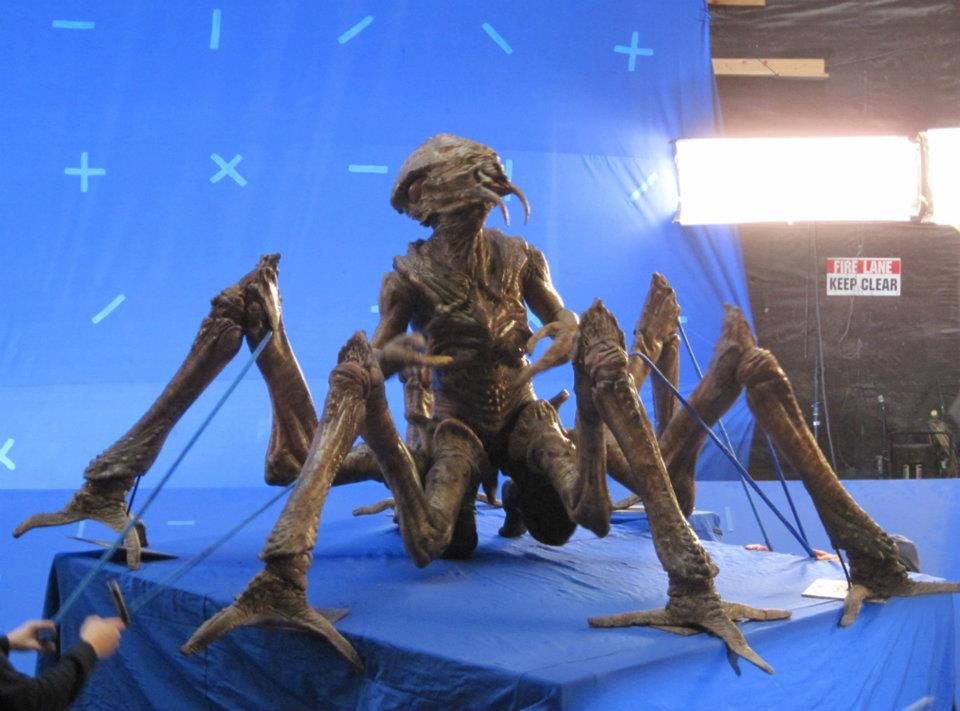
Falling Skies is a science fiction television series depicting the invasion of the Earth, or more specifically America, by advanced beings from another world bent on their destruction. Their foot soldiers are multi-legged creatures called “Skitters.” The series is loosely based on an inverse telling of the American Civil War, in which the technologically superior invaders from the northern USA fight against a ragtag group of survivors who take refuge in the heart of South Carolina. As is common in war, food becomes scarce for the human resistance, and the people must find alternate sources to sustain them. In their desperation, a few of the survivors turn to eating the six-legged, two-armed skitter soldiers they have defeated.
As you may have guessed, one of the survivors takes the first bite — initially pretending that it is toxic for a laugh — and quickly succumbs to a horrible acidic reaction that dissolves his lower jaw, dropping it to the ground as he chokes and dies in front of his screaming compatriots. Clearly, do not eat the Skitters.
A Melting Pot of Ideas
It is simple to write on the page of a script “…and his face melts,” but what does that look like? Does his face turn to jelly like a melting Nazi? The scenes from Raiders of the Lost Ark, and Incredible Melting Man are so rooted in our cultural experience, that one quickly goes to that image. Most of that aesthetic is married to the practical effects that were used to depict it — namely substances that melt under heat, or chemical reaction. Digital melting heads in the pilot of FRINGE were based on a makeup worn on-set that appeared to turn the skin of the actor to jelly — which motivated the digital skin to act far more rubber-like, stretching until it tore asunder.

One of the design philosophies of the dMFX team at MastersFX at the time, was to avoid unnecessary “sparkle,” or visuals that looked fancy for the sake of looking fancy. It is necessary to root the effect to some physical pseudo-logic. It has to appear if it could physically happen. One of the ways to assure that, is to either sculpt things physically, scan them into the computer, and manipulate them to the scene, shoot a practical element, or manipulate the existing photographed imagery rather than replace it with a digital construct. Since the digital team worked closely with the practical effects department, the goal was to leverage their expertise, and extend their capability with the digital tools.
Using photographs of employees taken with an iPhone, and random anatomical bits laying around the shop from previous jobs (it’s a makeup effects house, there is always something lying around) a very rough visual concept quickly came together. The idea was that the skitter meat would react with the saliva of the victim, causing it to foam, and multiply its digestive effect, dissolving the tongue, and esophagus. As the victim spat out the substance, it dissolved his skin, and sinews around the jaw, eventually dislodging the lower jaw behind his dangling face, and out his exposed neck as he falls to his gruesome demise.
The plan was to film the actor with several tubes coming up to his mouth, spewing fake blood and sputum, then clear the set, and photograph a dissolving prop face and jaw set to dissolve through some more caustic chemical mix in the same lighting.

Fabricating the Effect
Once the design and plan were approved by the client, the Makeup Effects team sculpted a human jawline using an existing life cast, rather than getting one from the actual actor who would be playing the walk-on role, since he was not available in time. A simple jaw mechanism with a release was built into an under-skull so that performers could manipulate a reaction, and eventually drop the dislocated jaw to the ground, complete with teeth and protruding bone and viscera. Since it was specifically for the dissolving flesh and animated jaw, little effort was needed to make the skin and appearance perfectly match.
Since this was going to be photographed on-set with actors and crew around, and not in post-production, it was clear that a heat-based melting event was impractical. The artists on Raiders of the Lost Ark, used a gelatin-based sculpture and multiple heat guns photographed with time-lapse cameras. Time is precious on-set, so a chemically induced method was preferred.
At this point in the process, a number of solvent based chemicals, and plastics were considered. Unfortunately the byproduct of a lot of solvents is caustic, or produces poisonous gas during the reaction. A prime example of this kind of reaction, is the acid-for-blood effect in ALIEN, which uses acetone and styrofoam. Acetone is a chemical that the FDA has determined as safe as an indirect food additive — as it occurs naturally in the human body at lesser concentration — but is more concentrated for this specific use. Styrofoam is made of polystyrene, a petroleum product, and gases do escape that should probably not be inhaled. So safety is a concern when building these effects.

The final solution for melting the face was something far more banal. Vinyl-encapsulated cake frosting. You read that properly: Cake Frosting, in a thin skin of flesh colored vinyl dissolved by a proprietary mix of acetone, and some other equally banal kitchen chemicals. When the solution was first presented to the team, most looked on with a little disbelief. Assured that the trick had worked before, everyone forged ahead. There was little time to get the fake face and jaw completed, and shipped to Vancouver from Los Angeles for filming.
One can assume the odd descriptions in international customs if these items were questioned, but with several faces complete to cover a few takes, all the team could do was ship them north to Vancouver, and wait for the results. With practical effects, there is often a mix of experience and faith.
Plans Melt Away
The on-set Makeup Effects team in Vancouver, did a brilliant job of rigging the actor up with hoses near the corners of his mouth, and hiding them from the camera view as much as possible. On cue, the actor sputtered, moaned, and collapsed to the ground clutching for breath as pints of bloodied mucus appeared to flow down his chin and chest. “Cut! Print it!” Likely rolled off the lips of the Director, once they’d recorded a successful performance.
Then it rained. This is not unusual for Vancouver.
The element shoot was scrubbed.
A few days later, the fully intact faces, filled with cake frosting, arrived back in Los Angeles, and were promptly stored in a refrigerator, while we waited for editorial to deliver the selected performances.
Once footage arrived, it was handed off to the dMFX team for 3D match-moving (the process of exactly matching visual camera and object motion in a 3D computer environment), with Andersson Technologies Syntheyes 3D tracking software. As opposed to recovering the camera movement, and then recreating the movement of the character’s head and face separately, a simple stand-in 3D head was tracked as if it was an immovable object, with a camera floating around. This was referred to as a bone-track (or a rigid track). The bone track was fed into photogrammetry software to recreate as much of the actor’s head as possible from the tracked footage — just in case any digital elements were necessary.
The stabilized footage and the resulting 3D reconstruction automatically from the footage and bone-track can be seen below.
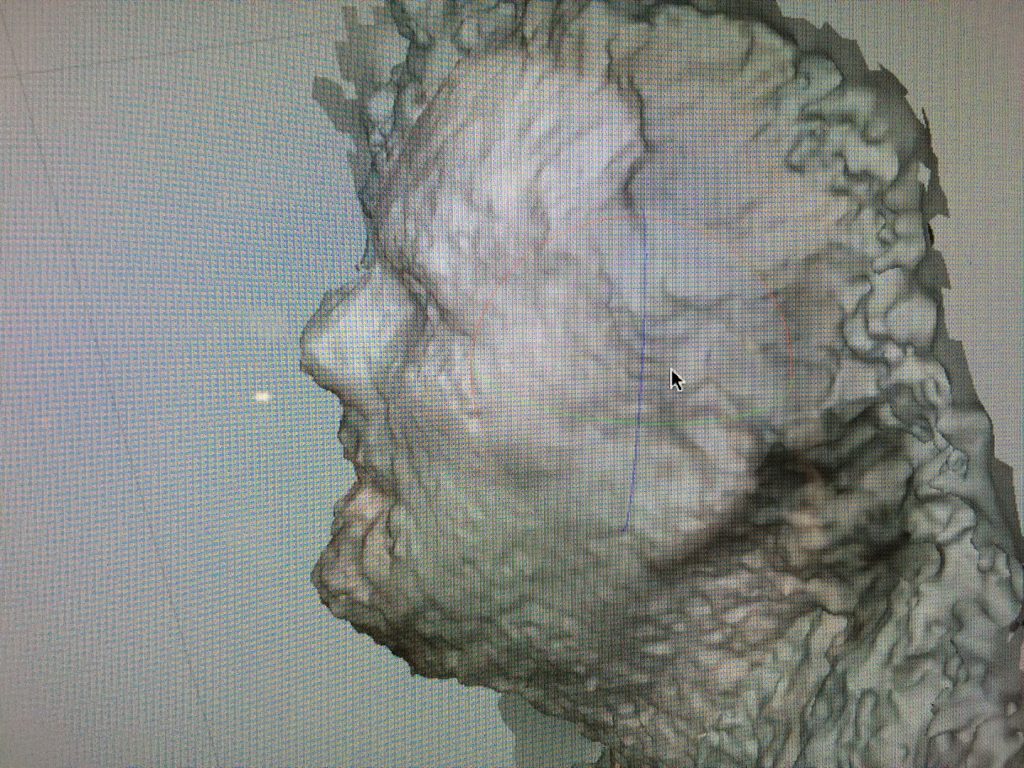
The recovered photogrammetry was part of experimentation at that time, and was used for a few lockdown points, which we discuss later, but was mostly used for general 3D positioning, of the stabilized plates, to lineup features.
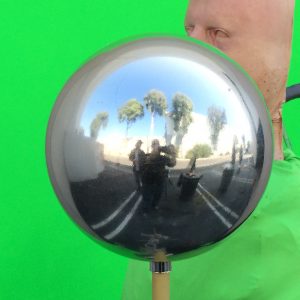 Thawing Out
Thawing Out
Since we missed the opportunity to use the actual production camera and lighting, The full 3D track provided a lens Field Of View, and focal length, as well as a range of angles to situate the camera to match. The lens data was translated to a matching set of lenses on a Canon 5-D reflex camera, and calibrated to properly balance color and lighting. Lighting the head for photography was fairly simple, as the footage from set is “Vancouver cloudy,” and a shady spot in the back parking lot would suffice.
The puppets were constructed six months prior, and were stuck in cold storage for that long. There was some trepidation that they might not work.
With the camera rolling, and a puppet performer in place, chemicals were pumped through tubes into the six-month-old vinyl-encapsulated “cake pan” in the shape of a human face. It dissolved in spectacular fashion, to cheers from the crew. A green screen cloth was placed below the puppet, to capture dripping viscera that would later be added to the shirt of the actor in the shot. Finally, an element of a disconnected jaw was heavily slimed with another water-based food additive, and filmed separately, so we could continue the move as far as needed in the final composite.
Here are some of the Behind the Scenes videos during the shoot, which show off the team’s jubilation that the plan worked as designed.
Digital Makeup
With the element photography complete, the remaining pieces of the puppets were photographed for photogrammetry re-creation, and turned into simple 3D models. These models were necessary to track the motion of the puppet, to stabilize its general position, so it could be connected to the bone-track from the actor’s performance.
All these seemingly simple elements would be combined with a combination of more 3D object tracking, and were mixed together via the compositing process on the computer.
The 3D tracking information was used to stabilize footage relative to each other, for the initial layout. Once the two plates were sufficiently in-line with each other, points on the actors face were locked to corresponding points on the puppet face, so that a seamless blend could be effected. The on-set spittle was rotoscoped frame by frame to create a matte which allowed the puppet to fade up from behind. As the fake blood and cake frosting dissolved on the puppet side, similar rotoscope was required to integrate the footage. The cloth was similarly pinned to the shirt, so that the stains on the green screen cloth would stick to the clothing worn by the actor.
Since the objects were stable, and all the movement was coming from the camera, it was only necessary to pin-down a few edges that moved relative to the performance – precise locations were sampled from the 3D model recovered earlier, to assist that process. The resulting stabilized composite of elements was virtually “re-photographed” through the moving camera, introducing appropriate motion blur. The fully stable method had one drawback, in that there was no physical movement of the puppet’s jowls and fluids from the overall motion.
To introduce the wobbling motion from the actor’s movement into the composite, points of the actor’s performance were motion tracked and attached to an image warper, which would bend the pixels around. The resulting motion track of each point was then offset in time one or two frames, while remaining generally attached to the same place. The difference in position was calculated, and applied to the warping tool — introducing a fleshy wobble that followed the dynamics of the performance. Similar wiggles of spittle were done by not only offsetting the warp point in time, but also vertically — allowing elements to dangle a bit, Finally, the separate jaw element’s position was stabilized and animated to fall down, rotating as it was photographed — which completes the illusion.
Here are the completed shots near final, and in the show below:
You Are What You Eat
It was an interesting solution to depict the consequences of eating a toxic animal, using actual food — but that’s the alchemy of Makeup Effects. The plan was to photograph that effect on the day of the shoot to take advantage of the lighting and production cameras, but due to weather complications, a better solution resulted — stereotypically fixing it in post. The “happy accidents” that are the result of photographing an unpredictable physical event, were far superior to inventing something in the digital realm, and constantly fighting the result to look real, especially in the time allotted. The costs were similar, but the joined approach with the digital makeup team, and the traditional makeup team, under one roof allowed for shortcuts that would normally not be taken. Practical makeup effects leveraged the digital tools, as an extension of their toolkit, and digital effects enabled greater flexibility by sampling actual objects and events through photography, and photogrammetry. Advanced tools merely enhanced the ingenuity, rather than replacing it.
In the fine tradition of Hollywood fantasy and horror films, Falling Skies took the time to mix and match, and create a cautionary tale about dining habits that we should all remember.
AG


